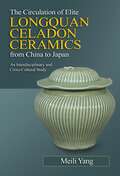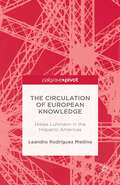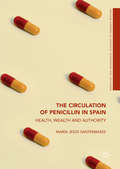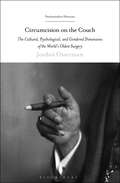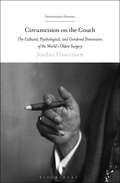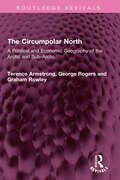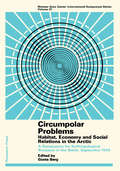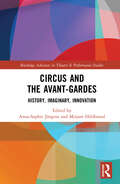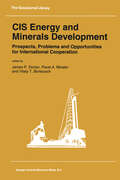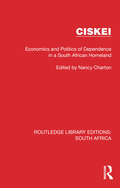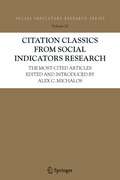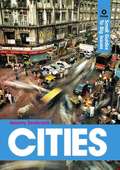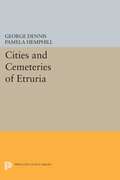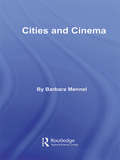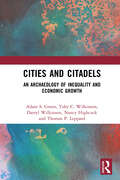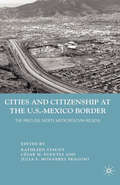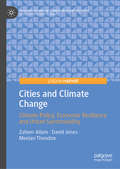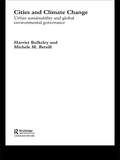- Table View
- List View
The Circulation of Elite Longquan Celadon Ceramics from China to Japan: An Interdisciplinary and Cross-Cultural Study
by Meili YangChinese Longquan celadon, a type of green-glazed ceramic, is one of the most famous branded and trade products, particularly during the 13th and 14th centuries. Its archaeological and historical materials possess multiple attributes with plentiful cultural information. The objective of the present book is to vivify these materials and provide a broader perspective and additional methodologies to review and gain a new and more profound understanding of Longquan celadon. The first part of this book focuses on elite Longquan celadon in China's Southern Song (1127-1278) and Yuan (1271-1368) periods. The second part focuses on elite Longquan celadon products as imports in medieval Japan. These products played a crucial role in shaping medieval Japanese culture.
The Circulation of European Knowledge: Niklas Luhmann In The Hispanic Americas
by Leandro Rodriguez MedinaThis book studies the circulation of social knowledge by focusing on the reception of Niklas Luhmann's systems theory in Hispanic America. It shows that theories need active involvement from scholars in the receiving field in order to travel.
The Circulation of Penicillin in Spain: Health, Wealth and Authority
by María Jesús SantesmasesThis book reconstructs the early circulation of penicillin in Spain, a country exhausted by civil war (1936–1939), and oppressed by Franco’s dictatorship. Embedded in the post-war recovery, penicillin’s voyages through time and across geographies – professional, political and social – were both material and symbolic. This powerful antimicrobial captivated the imagination of the general public, medical practice, science and industry, creating high expectations among patients, who at times experienced little or no effect. Penicillin’s lack of efficacy against some microbes fueled the search for new wonder drugs and sustained a decades-long research agenda built on the post-war concept of development through scientific and technological achievements. This historical reconstruction of the social life of penicillin between the 1940s and 1980s – through the dictatorship to democratic transition – explores political, public, medical, experimental and gender issues, and the rise of antibiotic resistance.
The Circulation of Penicillin in Spain: Health, Wealth and Authority
by María Jesús SantesmasesThis book reconstructs the early circulation of penicillin in Spain, a country exhausted by civil war (1936–1939), and oppressed by Franco’s dictatorship. Embedded in the post-war recovery, penicillin’s voyages through time and across geographies – professional, political and social – were both material and symbolic. This powerful antimicrobial captivated the imagination of the general public, medical practice, science and industry, creating high expectations among patients, who at times experienced little or no effect. Penicillin’s lack of efficacy against some microbes fueled the search for new wonder drugs and sustained a decades-long research agenda built on the post-war concept of development through scientific and technological achievements. This historical reconstruction of the social life of penicillin between the 1940s and 1980s – through the dictatorship to democratic transition – explores political, public, medical, experimental and gender issues, and the rise of antibiotic resistance.
Circumcision on the Couch: The Cultural, Psychological, and Gendered Dimensions of the World's Oldest Surgery (Psychoanalytic Horizons)
by Jordan OssermanPenises, and the things people do with them, have been subjects of controversy for a long time. This book examines how one thing that some people do to penises-remove the foreskin-has become a site upon which vital questions of gender, race, religion, sexuality, and psychic life are negotiated. While most contemporary work on the subject is concerned with whether circumcision is right or wrong, safe or harmful, Circumcision on the Couch takes as its starting point that the significance of male circumcision exceeds anatomical and juridical considerations. Deploying a feminist Lacanian framework, while drawing from a wide range of archival sources and critical thought, Jordan Osserman asks: How can psychoanalysis help us shed light on the ideologies, discourses, and fantasies surrounding circumcision and the impassioned stances for and against it? And how might the history of circumcision, in turn, allow us to re-assess and clarify how we understand the split (or “snipped”) subject of psychoanalysis?
Circumcision on the Couch: The Cultural, Psychological, and Gendered Dimensions of the World's Oldest Surgery (Psychoanalytic Horizons)
by Jordan OssermanPenises, and the things people do with them, have been subjects of controversy for a long time. This book examines how one thing that some people do to penises-remove the foreskin-has become a site upon which vital questions of gender, race, religion, sexuality, and psychic life are negotiated. While most contemporary work on the subject is concerned with whether circumcision is right or wrong, safe or harmful, Circumcision on the Couch takes as its starting point that the significance of male circumcision exceeds anatomical and juridical considerations. Deploying a feminist Lacanian framework, while drawing from a wide range of archival sources and critical thought, Jordan Osserman asks: How can psychoanalysis help us shed light on the ideologies, discourses, and fantasies surrounding circumcision and the impassioned stances for and against it? And how might the history of circumcision, in turn, allow us to re-assess and clarify how we understand the split (or “snipped”) subject of psychoanalysis?
The Circumpolar North: A Political and Economic Geography of the Arctic and Sub-Arctic (Routledge Revivals)
by Terence Armstrong George Rogers Graham RowleyFirst Published in 1978, The Circumpolar North is designed for anyone with a more than superficial interest in the northern regions of our planet, geographical, economic, social, or political. The primary importance of North today is as a source of raw materials, as a world crossroads, and as a touchstone of the way nations behave towards their minority groups. Strategic considerations have led to the expenditure of vast sums of money; but world population expansion has not yet affected the northlands and their preservation in a natural state is still a feasible objective. The authors are experts in their own areas and have provided regional chapters on each of the land and ocean areas. The book compares the different approaches of the countries involved and deals also, in the context of the northern seas, with another political dimension – the relations between nations and their success in achieving international management of resources. This is an interesting read for scholars of geography, international relations and international economics.
The Circumpolar North: A Political and Economic Geography of the Arctic and Sub-Arctic (Routledge Revivals)
by Terence Armstrong George Rogers Graham RowleyFirst Published in 1978, The Circumpolar North is designed for anyone with a more than superficial interest in the northern regions of our planet, geographical, economic, social, or political. The primary importance of North today is as a source of raw materials, as a world crossroads, and as a touchstone of the way nations behave towards their minority groups. Strategic considerations have led to the expenditure of vast sums of money; but world population expansion has not yet affected the northlands and their preservation in a natural state is still a feasible objective. The authors are experts in their own areas and have provided regional chapters on each of the land and ocean areas. The book compares the different approaches of the countries involved and deals also, in the context of the northern seas, with another political dimension – the relations between nations and their success in achieving international management of resources. This is an interesting read for scholars of geography, international relations and international economics.
Circumpolar Problems: Habitat, Economy, and Social Relations in the Arctic
by Gösta BergCircumpolar Problems: Habitat, Economy, and Social Relations in the Arctic contains papers presented at the Symposium on Circumpolar Problems, organized by the Nordic Council for Anthropological Research and held on September 14-21, 1969 in Lulea, Sweden and Tromso, Norway. Organized into 22 chapters, this book begins with some comparisons between Greenlanders and Lapps regarding their relationship to the inclusive society. Subsequent chapters discuss the urbanization, industrialization, and changes in the family in Greenland during the reform period since 1950; ""conservation"" and ""destruction"" of traditional culture; and socio-economical transformation and modern ethnical development of the inhabitants of the Siberian polar zones of the north-eastern regions. Other chapters explain the migrations from nomad to urban districts in Northern Sweden; division of the Lapps into tradition areas; variations of settlement pattern and hunting conditions in three districts of Greenland; cultural concept in the Arctic Stone Age; and transition from hunting to nomadic economy in Finnmark.
Circus and the Avant-Gardes: History, Imaginary, Innovation (Routledge Advances in Theatre & Performance Studies)
by Anna-Sophie Jürgens and Mirjam HildbrandThis book examines how circus and circus imaginary have shaped the historical avant-gardes at the beginning of the 20th century and the cultures they help constitute, to what extent this is a mutual shaping, and why this is still relevant today. This book aims to produce a better sense of the artistic work and cultural achievements that have emerged from the interplay of circus and avant-garde artists and projects, and to clarify both their transhistorical and trans-medial presence, and their scope for interdisciplinary expansion. Across 14 chapters written by leading scholars – from fields as varied as circus, theatre and performance studies, art, media studies, film and cultural history – some of which are written together with performers and circus practitioners, the book examines to what extent circus and avant-garde connections contribute to a better understanding of early 20th century artistic movements and their enduring legacy, of the history of popular entertainment, and the cultural relevance of circus arts. Circus and the Avant-Gardes elucidates how the realm of the circus as a model, or rather a blueprint for modernist experiment, innovation and (re)negotiation of bodies, has become fully integrated in our ways of perceiving avant-gardes today. The book does not only map the significance of circus/avant-garde phenomena for the past, but, through an exploration of their contemporary actualisations (in different media), also carves out their achievements, relevance, and impact, both cultural and aesthetic, on the present time.
Circus and the Avant-Gardes: History, Imaginary, Innovation (Routledge Advances in Theatre & Performance Studies)
by Anna-Sophie Jürgens Mirjam HildbrandThis book examines how circus and circus imaginary have shaped the historical avant-gardes at the beginning of the 20th century and the cultures they help constitute, to what extent this is a mutual shaping, and why this is still relevant today. This book aims to produce a better sense of the artistic work and cultural achievements that have emerged from the interplay of circus and avant-garde artists and projects, and to clarify both their transhistorical and trans-medial presence, and their scope for interdisciplinary expansion. Across 14 chapters written by leading scholars – from fields as varied as circus, theatre and performance studies, art, media studies, film and cultural history – some of which are written together with performers and circus practitioners, the book examines to what extent circus and avant-garde connections contribute to a better understanding of early 20th century artistic movements and their enduring legacy, of the history of popular entertainment, and the cultural relevance of circus arts. Circus and the Avant-Gardes elucidates how the realm of the circus as a model, or rather a blueprint for modernist experiment, innovation and (re)negotiation of bodies, has become fully integrated in our ways of perceiving avant-gardes today. The book does not only map the significance of circus/avant-garde phenomena for the past, but, through an exploration of their contemporary actualisations (in different media), also carves out their achievements, relevance, and impact, both cultural and aesthetic, on the present time.
CIS Energy and Minerals Development: Prospects, Problems and Opportunities for International Cooperation (GeoJournal Library #25)
by James P. Dorian, Pavel A. Minakir and Vitaly T. BorisovichThe former Soviet Union possessed some of the world's largest reserves of energy and mineral resources. With the dissolution of the country in 1991, the former Soviet republics are now exercising complete control over their mining industries. The new Commonwealth of Independent States (CIS) consists of several new nations, well-endowed in hydrocarbons, metals, and industrial materials; efforts are now underway to boost development activities and attract foreign investment. Commonwealth members today are implementing policies to regulate energy and mineral development and enhance economic growth. This book provides a comprehensive overview of the energy and minerals industries of the CIS and other former Soviet republics outside the Commonwealth. Prospects for international cooperation and trade in hydrocarbons, metals, and nonmetals are examined, as are opportunities for joint ventures and technology transfers in mining. Economic relations between the CIS and several Asian nations are also analyzed. Contributors to the book from throughout the Commonwealth, Asia, Europe, and North America have a wide variety of backgrounds in the energy and mineral fields, including government, academia, and industry.
Ciskei: Economics and Politics of Dependence in a South African Homeland (Routledge Library Editions: South Africa #3)
by Nancy ChartonOriginally published in 1980, this book examines the ‘self-government’ constitution, administrative and party system of The Ciskei which was one of the black ‘homelands’ created by the government of the Republic of South Africa in its pursuit of ‘separate development’. (It has since been reintegrated into South Africa, becoming part of the Eastern Cape Province). The book discusses how, because poverty was endemic and agricultural resources poorly developed the region was dependent on the encapsulating white area for jobs, capital, entrepreneurial skills and markets. It examines how the existence of job opportunities in contiguous white areas has stimulated the growth of black towns, it has also inhibited their development. The book considers the role of the mass media played, illustrating how both traditional oral forms and contemporary mass media depended ultimately on white input and were thus oriented towards white rather than black politics.
Ciskei: Economics and Politics of Dependence in a South African Homeland (Routledge Library Editions: South Africa #3)
by Nancy ChartonOriginally published in 1980, this book examines the ‘self-government’ constitution, administrative and party system of The Ciskei which was one of the black ‘homelands’ created by the government of the Republic of South Africa in its pursuit of ‘separate development’. (It has since been reintegrated into South Africa, becoming part of the Eastern Cape Province). The book discusses how, because poverty was endemic and agricultural resources poorly developed the region was dependent on the encapsulating white area for jobs, capital, entrepreneurial skills and markets. It examines how the existence of job opportunities in contiguous white areas has stimulated the growth of black towns, it has also inhibited their development. The book considers the role of the mass media played, illustrating how both traditional oral forms and contemporary mass media depended ultimately on white input and were thus oriented towards white rather than black politics.
Citation Classics from Social Indicators Research: The Most Cited Articles Edited and Introduced by Alex C. Michalos (Social Indicators Research Series #26)
by Alex C. MichalosSocial Indicators Research: An International and Interdisciplinary Journal for Quality-of-Life Measurement was founded by Alex C. Michalos and published its first issue in March 1974. It has been the leading journal for scholarly research in its field for over thirty years. This volume is published in celebration of that record of accomplishment. The 19 articles assembled here are a selection drawn from the 34 (2.4%) most frequently cited articles in the journal’s history. An introductory essay written by Michalos explains the historical and scientific importance of each article in the development of social indicators or quality-of-life research. It provides a rare overview of the perceived scientific problems that researchers around the world addressed in the first three decades of exploration, as well as a view of some of the problems to be addressed in the future. A short essay describing the origins of the journal by its founder is also included. Anyone interested in having a single volume that contains some of the best research produced in this field will find this volume irresistible.
Cities: Small Guides to Big Issues (Small Guides to Big Issues)
by Jeremy SeabrookWhat are the global challenges of the twenty-first century? Every year tens of millions of people abandon rural areas for life in the city. With education, health care and even safe water in short supply, cities risk becoming sites of violent conflict for future generations. And yet world governments are doing little to address these demographic shifts.*BR**BR*Jeremy Seabrook offers a vivid portrait of the lives of people who migrate from impoverished villages to towns and cities, the changes they face, and the impact these changes have on their psyche and well-being. Contrasting the attitudes of today's governments with those of the past, the book provides a sharp critique of global policies, and an ideal introduction to the impact of urbanisation on modern life.*BR**BR*The Small Guides to Big Issues series de-bunks myths and raises questions about the global economic and political system and how it works. They are designed for campaigners and activists, students and researchers, and anyone interested in looking behind the headlines. Produced in partnership with Oxfam, each book provides an informative and thought-provoking guide to current trends and debates, and what needs to happen in order to end poverty and injustice.
Cities and Cemeteries of Etruria
by George Dennis Pamela HemphillThe best overall description of the remains and the topography of Etruscan sites. It conveys the fascination of a British traveler's path-breaking exploration of the sites in central Italy in the early 1840s and the obstacles he overcame to reach them.Originally published in 1985.The Princeton Legacy Library uses the latest print-on-demand technology to again make available previously out-of-print books from the distinguished backlist of Princeton University Press. These editions preserve the original texts of these important books while presenting them in durable paperback and hardcover editions. The goal of the Princeton Legacy Library is to vastly increase access to the rich scholarly heritage found in the thousands of books published by Princeton University Press since its founding in 1905.
Cities and Cinema
by Barbara MennelFilms about cities abound. They provide fantasies for those who recognize their city and those for whom the city is a faraway dream or nightmare. How does cinema rework city planners’ hopes and city dwellers’ fears of modern urbanism? Can an analysis of city films answer some of the questions posed in urban studies? What kinds of vision for the future and images of the past do city films offer? What are the changes that city films have undergone? Cities and Cinema puts urban theory and cinema studies in dialogue. The book’s first section analyzes three important genres of city films that follow in historical sequence, each associated with a particular city, moving from the city film of the Weimar Republic to the film noir associated with Los Angeles and the image of Paris in the cinema of the French New Wave. The second section discusses socio-historical themes of urban studies, beginning with the relationship of film industries and individual cities, continuing with the portrayal of war torn and divided cities, and ending with the cinematic expression of utopia and dystopia in urban science fiction. The last section negotiates the question of identity and place in a global world, moving from the portrayal of ghettos and barrios to the city as a setting for gay and lesbian desire, to end with the representation of the global city in transnational cinematic practices. The book suggests that modernity links urbanism and cinema. It accounts for the significant changes that city film has undergone through processes of globalization, during which the city has developed from an icon in national cinema to a privileged site for transnational cinematic practices. It is a key text for students and researchers of film studies, urban studies and cultural studies.
Cities and Cinema
by Barbara MennelFilms about cities abound. They provide fantasies for those who recognize their city and those for whom the city is a faraway dream or nightmare. How does cinema rework city planners’ hopes and city dwellers’ fears of modern urbanism? Can an analysis of city films answer some of the questions posed in urban studies? What kinds of vision for the future and images of the past do city films offer? What are the changes that city films have undergone? Cities and Cinema puts urban theory and cinema studies in dialogue. The book’s first section analyzes three important genres of city films that follow in historical sequence, each associated with a particular city, moving from the city film of the Weimar Republic to the film noir associated with Los Angeles and the image of Paris in the cinema of the French New Wave. The second section discusses socio-historical themes of urban studies, beginning with the relationship of film industries and individual cities, continuing with the portrayal of war torn and divided cities, and ending with the cinematic expression of utopia and dystopia in urban science fiction. The last section negotiates the question of identity and place in a global world, moving from the portrayal of ghettos and barrios to the city as a setting for gay and lesbian desire, to end with the representation of the global city in transnational cinematic practices. The book suggests that modernity links urbanism and cinema. It accounts for the significant changes that city film has undergone through processes of globalization, during which the city has developed from an icon in national cinema to a privileged site for transnational cinematic practices. It is a key text for students and researchers of film studies, urban studies and cultural studies.
Cities and Citadels: An Archaeology of Inequality and Economic Growth
by Adam S. Green Toby C. Wilkinson Darryl Wilkinson Nancy Highcock Thomas LeppardCities and Citadels provides an urgent update of archaeology’s engagement with economic theory. Recent events have forced a major reassessment of economic thinking. In the wake of the 2008 Great Recession and the economic impact of the COVID-19 Pandemic, the world finds itself in unprecedented times. Even though archaeology typically concerns itself with the remote past, it must also help us understand how we got to where we are today. This book takes up the challenging new theories of scholars like Thomas Piketty, Mariana Mazzucato and David Graeber and explores their importance for the study of human economies in ancient and prehistoric contexts. Drawing on case studies from the Neolithic to the Classical Era and spanning the globe, the authors put forward a new narrative of economic change that is relevant to the 21st century. This book speaks to the study of economics in all ancient societies and is suitable for researchers of archaeology, economics, economic history and all related disciplines.
Cities and Citadels: An Archaeology of Inequality and Economic Growth
by Adam S. Green Toby C. Wilkinson Darryl Wilkinson Nancy Highcock Thomas LeppardCities and Citadels provides an urgent update of archaeology’s engagement with economic theory. Recent events have forced a major reassessment of economic thinking. In the wake of the 2008 Great Recession and the economic impact of the COVID-19 Pandemic, the world finds itself in unprecedented times. Even though archaeology typically concerns itself with the remote past, it must also help us understand how we got to where we are today. This book takes up the challenging new theories of scholars like Thomas Piketty, Mariana Mazzucato and David Graeber and explores their importance for the study of human economies in ancient and prehistoric contexts. Drawing on case studies from the Neolithic to the Classical Era and spanning the globe, the authors put forward a new narrative of economic change that is relevant to the 21st century. This book speaks to the study of economics in all ancient societies and is suitable for researchers of archaeology, economics, economic history and all related disciplines.
Cities and Citizenship at the U.S.-Mexico Border: The Paso del Norte Metropolitan Region
by Kathleen Staudt & César M. Fuentes & Julia E. Monárrez FragosoThe volume is a cutting-edge, interdisciplinary approach to analyzing an enormously significant region in ways that clarify the kind of everyday life and work that is generated in a major urban global manufacturing site amid insecurity, inequality, and a virtually absent state.
Cities and Climate Change: Climate Policy, Economic Resilience and Urban Sustainability (Palgrave Studies in Climate Resilient Societies)
by Zaheer Allam David Jones Meelan ThondooThis book explores climate change responsiveness policies for cities and discusses why they have been slow to gain traction despite having been on the international agenda for the last 30 years. The contributing role of cities in accentuating the effects of climate change is increasingly demonstrated in the literature, underscoring the unsustainable models on which urban life has been made to thrive. As these issues become increasingly apparent, there are global calls to adopt more sustainable and equitable models, however doing so will mean the disruption of economies that have historically relied upon pollution-generating industries. In order to address these issues the authors examine them from a cross-disciplinary perspective, bringing in regional, local and urban standpoints to subsequently propose an alternative short-term economic model that could accelerate the adoption of climate change mitigation infrastructures and urban sustainability in urban areas. This book will be of particular value to scholars and students alike in the field of urbanism, sustainability and resilience, as well as practitioners looking at avenues for economically incentivizing sustainable development in various geographical context.
Cities and Climate Change (Routledge Studies in Physical Geography and Environment)
by Michelle Betsill Harriet BulkeleyClimate change is one of the most challenging issues of our time. As key sites in the production and management of emissions of greenhouse gases, cities will be crucial for the implementation of international agreements and national policies on climate change. This book provides a critical analysis of the role of cities in addressing climate change and the prospects for urban sustainability. Cities and Climate Change is the first in-depth analysis of the role of cities in addressing climate change. The book argues that key challenges concerning the resources and powers of local government, as well as conflicts between local goals for economic development and climate change mitigation, have restricted the level of local action on climate change. These findings have significant implications for the prospects of mitigating climate change and achieving urban sustainability. This book provides a valuable interdisciplinary analysis of these issues, and will appeal to students and researchers interested in sustainability at local and global scales.
Cities and Climate Change (Routledge Studies in Physical Geography and Environment)
by Michelle Betsill Harriet BulkeleyClimate change is one of the most challenging issues of our time. As key sites in the production and management of emissions of greenhouse gases, cities will be crucial for the implementation of international agreements and national policies on climate change. This book provides a critical analysis of the role of cities in addressing climate change and the prospects for urban sustainability. Cities and Climate Change is the first in-depth analysis of the role of cities in addressing climate change. The book argues that key challenges concerning the resources and powers of local government, as well as conflicts between local goals for economic development and climate change mitigation, have restricted the level of local action on climate change. These findings have significant implications for the prospects of mitigating climate change and achieving urban sustainability. This book provides a valuable interdisciplinary analysis of these issues, and will appeal to students and researchers interested in sustainability at local and global scales.
